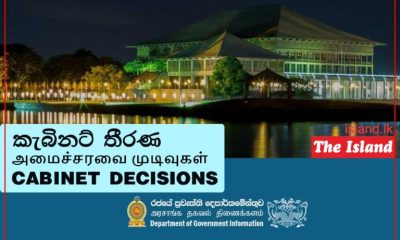Business
Local milk production drastically falling due to lack of imported cattle feed

Lack of veterinary medicine for cows, spare parts for chilling centres aggravate situation
by Sanath Nanayakkare
The All Island Dairy Association (AIDA) yesterday urged the government to take immediate action to prioritise the importation of quality cattle feed in the backdrop of dwindling milk production in the country.
They point out that proper micro-nutrients and vitamins from quality imported feed is an essential part in their industry as livestock constitutes a key element in the supply chain.
They say that it is imperative that feed such as maize silage is readily available as it would greatly assist in sustaining the industry because feeding cattle with maize silage as a major diet and protein source has a positive impact on the milk yield, milk composition, body weight change and quality of cow milk by-products.
AIDA says that the restrictions placed on imports due to the foreign currency crisis is crippling their industry due to these reasons.
Binesh Pananwala, President of AIDA said,” As an industry with endless potential to help the economy, the dairy industry is one of the most important industries in the country. However, rising costs, scarcity of feed, vitamins, fuel and fertiliser requirements of different fodder crops and the difficulty in importation of maize have greatly put the industry’s survival at risk.”
“Lack of quality animal feed has largely disrupted the dairy industry’s supply chain. If the livestock does not receive essential micronutrients and vitamins from maize silage, the physical wellbeing of cows get affected, which thereby affects milk production. Veterinary professionals have also continuously expressed their concern about the shortage of medicines such as antibiotics and anaesthetics required for operations,” he said.
A.C.H Munaweera, Consultant and General Manager of AIDA said, “The impact of the foreign exchange crisis is felt in multiple aspects of our industry. The industry is already struggling to sustain itself and we are unable to meet the demand for fresh milk and powdered milk. Milk production has reduced by a great deal already and if not rectified, it will spell disaster for the industry in the near future,” he said.
“The government of Sri Lanka has provided permits for the importation of maize on a case-by-case basis. But fodder importers and dairy companies have been struggling to import these inputs due to lack of foreign exchange and banks find it difficult to honour Letters of Credit (LCs) for importers to send in the raw materials we need,” they said.
Nishantha Jayasooriya, immediate past president of AIDA said, “The entire industry has felt the tremendous impact of the crisis. The livestock farmers, producers, input suppliers and distributors have all been affected by rising costs and lack of resources. If conscious decisions and changes to fiscal and monitory policy are not made, the industry will suffer even further as it will be unable to meet the demand for both fresh milk and milk powder.”
Gamini Rajapaksha, Treasurer of AIDA said, “Processing and value additions are integral and vital parts of the dairy industry. Dearth of foreign exchange and consequential scarcity of fuel, electricity etc. have adversely affected the processors. Some of the leading dairies are unable to operate their plants due to lack of power, which forces them to refuse supplies of milk from the farmers. This has directly affected the livelihood of rural dairy farmer. Chilling tanks at milk collection centres cannot be operated, causing large volumes of milk to be discarded. Another aspect is the importation of equipment and spare parts for the dairy processing plants. Many dairy plants will be compelled to stop production altogether unless they are able to import spare parts within the next few weeks. If urgent steps are not taken to remedy the situation, the entire dairy industry will come to a halt.”
Business
Code of Ethics for capital market influencers in the pipeline

The Securities and Exchange Commission (SEC) of Sri Lanka is planning to introduce a Code of Ethics or a set of guidelines for the activities of capital market influencers to protect the public from ongoing scams involving the swindling money from potential investors in the share market.
“The market regulator has already identified Blue Ocean Securities Limited and Gladius South Asia as involved in such scams, which are being investigated by the relevant authorities, said Deputy Director General of the SEC Tushara Jayaratne.
The Deputy Director General also said that Gladius was using their their logo in a fraudulent manner to promote their business as well.
He said Blue Ocean has been involved in asking investors to start trading through an app named BOMate Nd. ‘Through this app, you can’t trade shares. But the money transaction goes through this app and the SEC system does not see these transactions, Jayaratne explained.
“The money is going somewhere else, Jayaratne told journalists at a media briefing yesterday held at the SEC auditorium, WTC building, Colombo.
Jayaratne said the SEC has already made complaints to both the Criminal Investigation Department (CID) of the police and the Financial Intelligence Unit (FIU) of the Central Bank.
The Deputy Director General said the second company, Gladius South Asia, has been involved in asking investors not to invest their money in the local stock market, but to do so in the markets in foreign countries.
He also said that the SEC has adopted 12 key capital market development projects to increase the number of capital market investors.
“The Introduction of a Code of Ethics and guidelines for registered investment advisers will help to develop the market in an efficient and effective way, he said.
Jayaratne, however, said that the Sri Lankan share market is not full of scams and that people can have confidence in the market.
“Our market is somewhat free and fair. From the perspective of investors, you also have a responsibility to be careful when investing in the market, he added.
By Hiran H Senewiratne
Business
Norway supports flood-affected communities in Sri Lanka

Norway is providing more than USD 2.4 million to assist those affected by severe flooding in Sri Lanka.
“Norway is contributing emergency assistance to people who have lost both their homes and livelihoods in Sri Lanka. A rapid response is crucial to ensure that those affected have shelter, food, healthcare and support to rebuild their communities,” said Norway’s Minister of International Development, Åsmund Aukrust.
The United Nations estimates that nearly 11 million people have been impacted by catastrophic floods and landslides across large parts of South and Southeast Asia. Sri Lanka, Indonesia, Thailand, Vietnam and Malaysia have experienced record rainfall since 17 November. In total, approximately 1,600 people have lost their lives, and 1.2 million have been forced to leave their homes. Critical infrastructure such as houses and roads has been destroyed, and health risks are increasing due to waterborne diseases and poor sanitation.
“Norway is now contributing NOK 20 million (approx. USD 2 million) to the Red Cross Movement and the UN system in Sri Lanka. These organisations have presence in the country and the capacity to respond quickly based on local needs,” Aukrust said.
Sri Lanka is among the hardest-hit countries. On 28 November, Cyclone Ditwah struck the country, bringing heavy rain and strong winds. The cyclone triggered landslides and caused the most severe floodsing in recent history. The Sri Lankan authorities have led the search and rescue operations and allocated significant resources for immediate relief. “When disasters of this magnitude occur, it is vital that the international community and countries like Norway step up and support local actors in managing the crisis,” Aukrust said.
In addition, the UN Central Emergency Response Fund (CERF) has allocated USD 4.5 million for flood response in Sri Lanka. Around one in ten dollars in the fund comes from Norway.
Norway is also assisting flood-affected communities in Sri Lanka through an immediate response mechanism in the World Food Programme (WFP). The International Labour Organization (ILO) has re-allocated around USD 100,000 in a Norway-funded job generation project, to assist flood-affected participants. Furthermore, Norway has funded a UN expert to help coordinate ongoing relief efforts in the affected areas.
Business
Janashakthi Finance appoints Sithambaram Sri Ganendran as CEO

Janashakthi Finance PLC, formerly known as Orient Finance PLC and a subsidiary of JXG (Janashakthi Group), announces the appointment of Sithambaram Sri Ganendran as the Chief Executive Officer.
Sri Ganendran, who has held the position of Chief Operating Officer since September 2024, stepped in as Acting Chief Executive Officer during the past four months.
He brings with him almost 27 years of extensive experience in banking. Throughout his extensive career, he has held senior management roles in multiple local and international banks, where he acquired in-depth knowledge in operations, branch banking (across retail and SME sectors), operational risk, business continuity management, business integration, process reengineering, operational excellence, sales governance and credit card operations. He holds a plethora of qualifications including an MBA from American City University. He is a Fellow of the Chartered Institute of Management Accountants (CIMA) in the United Kingdom, and an Associate Member of the Chartered Institute of Securities and Investments (CISI), and a member of the Association of Professional Bankers of Sri Lanka.
Rajendra Theagarajah, Chairman of Janashakthi Finance PLC, said, “We are delighted to welcome Sithambaram Sri Ganendran to this important leadership role at a pivotal moment in our journey. His wealth of experience, proven track record, and people-focused leadership style make him well suited to strengthen and guide Janashakthi Finance, ensuring efficient continuity in all ongoing operations.”
The appointment of Sri Ganendran as Chief Executive Officer, reinforces Janashakthi Finance’s deep commitment to seamless operations and growth. It also underscores its dedication to vision of delivering trusted financial solutions, while continuously exploring opportunities for innovation and expansion to serve its customers and communities more efficiently.
-

 Business7 days ago
Business7 days agoCabinet approves establishment of two 50 MW wind power stations in Mullikulum, Mannar region
-

 Features4 days ago
Features4 days agoWhy Sri Lanka Still Has No Doppler Radar – and Who Should Be Held Accountable
-

 Features6 days ago
Features6 days agoDitwah: A Country Tested, A People United
-

 News6 days ago
News6 days agoRs 1. 3 bn yahapalana building deal under investigation
-

 News7 days ago
News7 days agoCabinet approves the transfer of the constructions and land reserved for the Kiinniya University to the Ministry of Foreign Affairs, Foreign Employment, and Tourism
-

 News6 days ago
News6 days agoFormer SAARC SG Esala Weerakoon calls for ‘South Asian Climate Compact’
-

 Business6 days ago
Business6 days agoFluctuating fortunes for bourse in the wake of selling pressure
-

 Opinion6 days ago
Opinion6 days agoComfort for some, death for others: The reality of climate change













